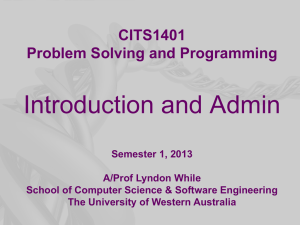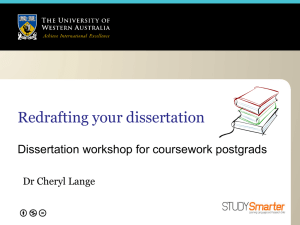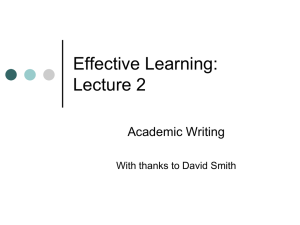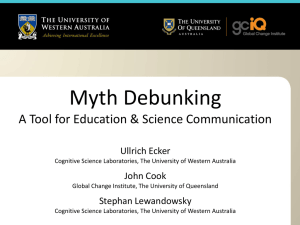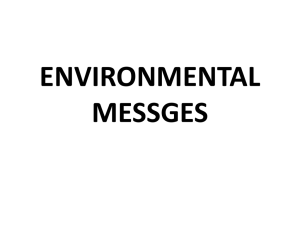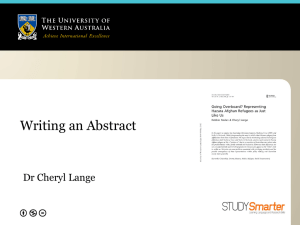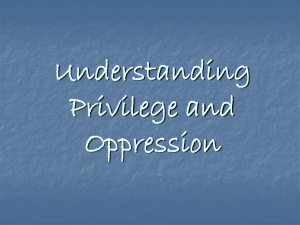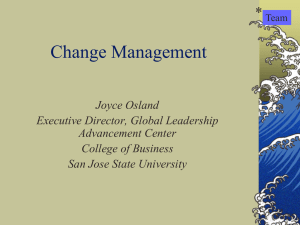Misinformation
advertisement
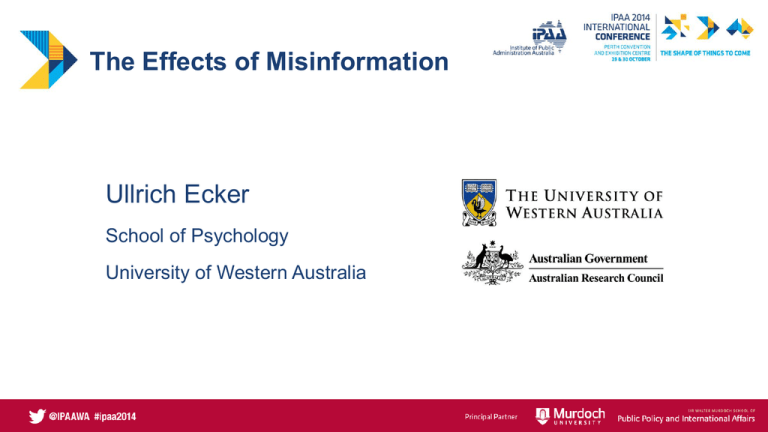
The Effects of Misinformation Ullrich Ecker School of Psychology University of Western Australia The Continued Influence of Misinformation • Misinformation (initially plausible/believed) will continue to influence memory, reasoning and decision making after corrections • Even when people believe and remember the correction ullrich.ecker@uwa.edu.au Misinformation everywhere Misinformation effects: Autism scare and MMR uptake Misinformation: How is it spread? • Inadvertently (in dubio pro reo) – Media • Pressures associated with competition and 24/7 news cycle (less fact-checking) • Obsession with “balanced” coverage even in the absence of balanced evidence – Social media: • No fact-checking • Information spread based on potential to elicit an emotional reaction in the recipient (not based on veracity; Berger, 2011) • On purpose (vested interests…) ullrich.ecker@uwa.edu.au Misinformation – Why believe it? • • • • People want to understand causalities, in particular in case of – Unusual events – Negative events Helps avoid re-occurrence But: Absence of good explanation opens door for misinformation In other words: People build mental models of the world and they prefer complete models ullrich.ecker@uwa.edu.au Misinformation – Why believe it? • • • • Deluge of information Limited resources – Time – Access to highest-quality information – Cognitive capacity – Motivation Impossible to thoroughly and objectively evaluate all evidence Heuristics – How does this fit with what I already (think I) know? – How does this fit with what I believe? – What do other people think about this? Simple solution? • Simple solution? Tell people it’s wrong… • Simple retractions of misinformation are ineffective “Information Deficit Model” – Once communicated and processed by the individual, it is no longer possible to just “take it back” by saying the information given was incorrect (“Mud sticks”) ullrich.ecker@uwa.edu.au Example lab study • • Critical information: “Spike in seizures caused by new compound vaccine.” Retraction: “Review finds no relation between the new vaccine and the seizures.” • Measure: Memory, inferential reasoning, behavioural intentions ullrich.ecker@uwa.edu.au Post-retraction reliance on misinformation …despite demonstrably remembering the retraction …with no motivation to believe the initial incorrect version Reliance on misinformation Ecker et al., 2011a Retractions create gaps MYTH Removing a myth leaves a gap People hate gaps! “Removed” misinformation is actually still in memory, and people use it even when they know it is wrong! ullrich.ecker@uwa.edu.au Fill the gap …Unless… The gap can be filled with plausible alternative information FACT Replace with alternative narrative ullrich.ecker@uwa.edu.au Example • • Critical information: “Spike in seizures caused by new compound vaccine.” Retraction: “Review finds no relation between the new vaccine and the seizures. Seizures were caused by a virus.” ullrich.ecker@uwa.edu.au Post-retraction reliance on misinformation Ecker et al., 2011a Effective Debunking I Create a gap with a retraction Fill the gap with a factual alternative Obvious problem when no alternative explanation is available, e.g. MH370 ullrich.ecker@uwa.edu.au Retractions can backfire • The last thing you want is to make things worse! • A few principles should guide retractions to avoid – The familiarity backfire effect – The worldview backfire effect ullrich.ecker@uwa.edu.au The Familiarity Backfire Effect Debunking a myth can reinforce the myth in people’s minds (Schwarz et al., 2007) The Familiarity Backfire Effect • When people read – “The side effects of the flu vaccine are worse than the flu.” • Followed by – “FALSE. The worst side effect would be a sore arm.” • What they may remember after a while is: – “The flu vaccine has side effects.” • This is because repeating the myth when retracting it makes it more familiar. • People remember and believe familiar things. If you correct myths, start with the facts Preliminary data; Cook et al. (2014) The Familiarity Backfire Effect • • Start with the facts… – “The vaccine is safe! The worst side effect would be a sore arm.” …then address the myth, clarifying immediately that misinformation will follow (puts people ‘on guard’). – “There are myths that the side effects are worse than the flu, but they are just that: myths.” Effective Debunking II Avoid the Familiarity Backfire Effect Don’t (unnecessarily) repeat myths; give the facts (first) ullrich.ecker@uwa.edu.au The Worldview Backfire Effect • If people have strong attitudes and beliefs – They will accept attitude-congruent misinformation – They will defend their beliefs – Retractions can cause stronger misbelief ullrich.ecker@uwa.edu.au The Worldview Backfire Effect Retraction attitude-incongruent e.g. You support party Y. You hear about misconduct in X. This is retracted: Belief in the misconduct increases. The attitudeincongruent retraction backfires 3 2 Belief change Retraction attitude-congruent e.g. You support party X. You hear about misconduct in X. This is retracted: Belief in the misconduct is reduced. 1 0 control -1 -2 -3 Preliminary data; Ecker et al. (2014) The Worldview Backfire Effect • Messages can be framed to affirm worldview – Conservatives are more likely to accept climate science when policy changes are framed as business opportunities (cf. Kahan, 2010) • Strong believers are difficult to persuade even with hard evidence – Efforts are best targeted towards undecided majority ullrich.ecker@uwa.edu.au The Use of Graphs (Nyhan & Reifler, 2011) Groups of scientists from several major institutions — NASA's Goddard Institute for Space Studies, the National Oceanic and Atmospheric Administration's National Climatic Data Center, the Japanese Meteorological Agency and the Met Office Hadley Centre in the United Kingdom — tally data collected by temperature monitoring stations spread around the world. All four records show peaks and valleys that vary in virtual sync with each other. They each show an increase in average global surface temperatures of approximately 0.5 degrees Celsius over the last three decades. Data from each source also indicate that the last decade is the warmest since 1940. % Agreement with Global Cooling (in Republicans; Nyhan & Reiffler, 2011) 40 Control Text 20 Graph 0 ullrich.ecker@uwa.edu.au Effective Debunking III Avoid the Worldview Backfire Effect Target majority; align correction to recipient ullrich.ecker@uwa.edu.au Effective Debunking IV Avoid communication barriers ullrich.ecker@uwa.edu.au Use graphs (and simple language) Summary of Recommendations • • • • • • • Provide alternative explanation when retracting a myth Focus on facts If myth repetition is necessary, start with facts and preface misinformation with an ‘Attention: Myth follows!’ warning Use informative, well-designed graphs Use simple language Take recipients’ worldview into account Target non-radical majority ullrich.ecker@uwa.edu.au Thank you! For a review, see Lewandowsky et al. (2012) article in Psychological Science in the Public Interest, available at: http://psi.sagepub.com/content/13/3.toc For a brief summary, see Cook & Lewandowsky’s (2011) Debunking Handbook, available at: http://sks.to/debunk For more literature & enquiries, please visit www.cogsciwa.com ullrich.ecker@uwa.edu.au Misinformation in the media Misinformation effects: The climate change consensus gap Cook et al., 2013 Doran & Zimmerman, 2009 Anderegg et al., 2010 Trustworthiness and Expertise No Effect effect of of trustworthiness expertise

